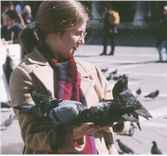|
Europe >
Venice > Life & Culture > Pigeons of Venice
Pigeons of Venice

ABOVE: A pigeon and friend in Venice's Piazza San
Marco.
By
Durant Imboden
Pigeons
once rivaled cats as the traditional, if unofficial, mascots of Venice. In A Venetian Bestiary, Jan Morris wrote:
"The pigeon is, if not actually sacred, at
least highly respected in Venice. You will never be offered him roasted in a Venetian
restaurant. On the contrary, sometimes invalid pigeons, having lost a leg perhaps in a
more than usually unseemly scramble for peanuts, become known individually to the waiters
at the Piazza cafés, and are thereafter privileged for life, allowed to preen themselves
on unoccupied tables, and fed wonderfully sustaining morsels of toasted sandwich. Pigeons
can get away with almost anything in Venice, and sometimes you will see one, all puffed up
with pride, swaggering into the narthex of the Basilica San Marco itself."
Morris added that the city fed the pigeons
for many years until an insurance company took on the job as an advertising gimmick in the
1950s. Each day, a company employee would strew corn about St. Mark's Square until the birds
descended en masse:
"Only for a second or two did the insurance
company get its money's worth: for there was just enough time to see, before the doves
destroyed the pattern, that the maize had been poured on the ground in the shape of two
huge letters--A.G., for Assicurazioni Generali."
In Venice: A Literary Companion, Ian Littlewood explained the
origins of the Piazza San Marco's pigeon colony:
 "According
to tradition, it was from the gallery [of the Basilica] where we are standing that the
original pigeons were released on Palm Sunday, weighted by pieces of paper tied to their
legs. Most of them ended up on the dinner table as part of the Doge's Easter largesse to
the populace, but the rugged survivors were felt to have earned St. Mark's protection. So
year by year a few more pigeons found refuge among the domes on the basilica. They have
since grown more numerous, and the enthusiasm of most tourists for the birds is
short-lived, but as the average visitor now spends less than twenty-four hours in the
city they still have plenty of friends." "According
to tradition, it was from the gallery [of the Basilica] where we are standing that the
original pigeons were released on Palm Sunday, weighted by pieces of paper tied to their
legs. Most of them ended up on the dinner table as part of the Doge's Easter largesse to
the populace, but the rugged survivors were felt to have earned St. Mark's protection. So
year by year a few more pigeons found refuge among the domes on the basilica. They have
since grown more numerous, and the enthusiasm of most tourists for the birds is
short-lived, but as the average visitor now spends less than twenty-four hours in the
city they still have plenty of friends."
A panoply of pigeons

Today, pigeons have formed colonies throughout the
city, and the estimated 100,000 birds far outnumber Venice's 60,000 human residents.
It can be disconcerting to walk down a
street and encounter several dozen pigeons flying toward you at head height.
They usually miss pedestrians, but not always. Juli Van Zyverden, an American
librarian who used to live
in Venice,
once told me how she'd seen a pigeon collide with an elderly man who wasn't quick enough
to duck. The man was bleeding, so she escorted him to a pharmacy for a clean-up and
bandage.

ABOVE: Could this be a scene from Alfred
Hitchcock's The Birds?
A few words on feeding the birds:
Many Venetians are in the habit of leaving out grain or bread for the
pigeons of the neighborhood. This is illegal under a decree that the Comune di
Venezia
issued late in 1997.
Also, sellers of pigeon food have been banned from the Piazza
San Marco since 2008, which means
it's now more difficult to bait yourself with grain to attract a living coat of
pigeons like this American tourist (who apparently wasn't ticklish):

About the author:
 Durant Imboden has
written about Venice, Italy since 1996.
He covered Venice and European travel at About.com for 4-1/2 years before launching
Europe for Visitors (including
Venice for Visitors) with Cheryl
Imboden in 2001. Durant Imboden has
written about Venice, Italy since 1996.
He covered Venice and European travel at About.com for 4-1/2 years before launching
Europe for Visitors (including
Venice for Visitors) with Cheryl
Imboden in 2001.
PC Magazine has called this "the premier visitors'
site for Venice, Italy." Over the years, it has helped more than 30 million
travelers. For more information, see About our site,
our Europe for Visitors
press clippings,
and
our reader testimonials.
| 
